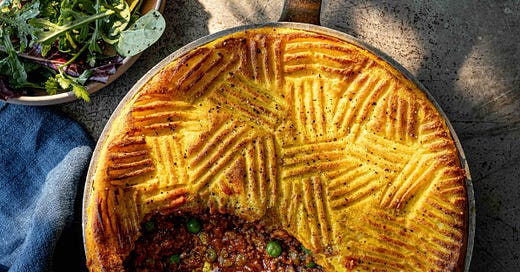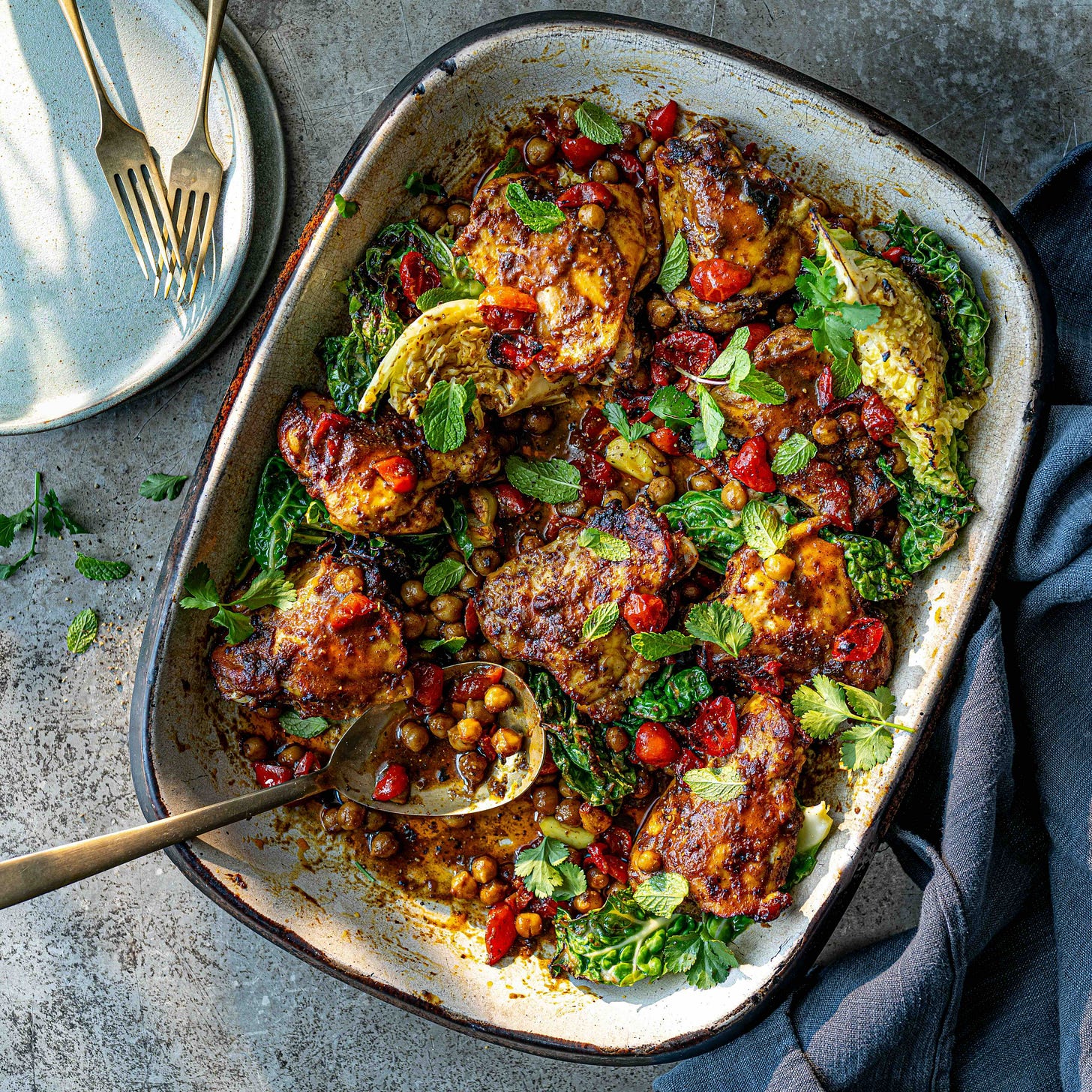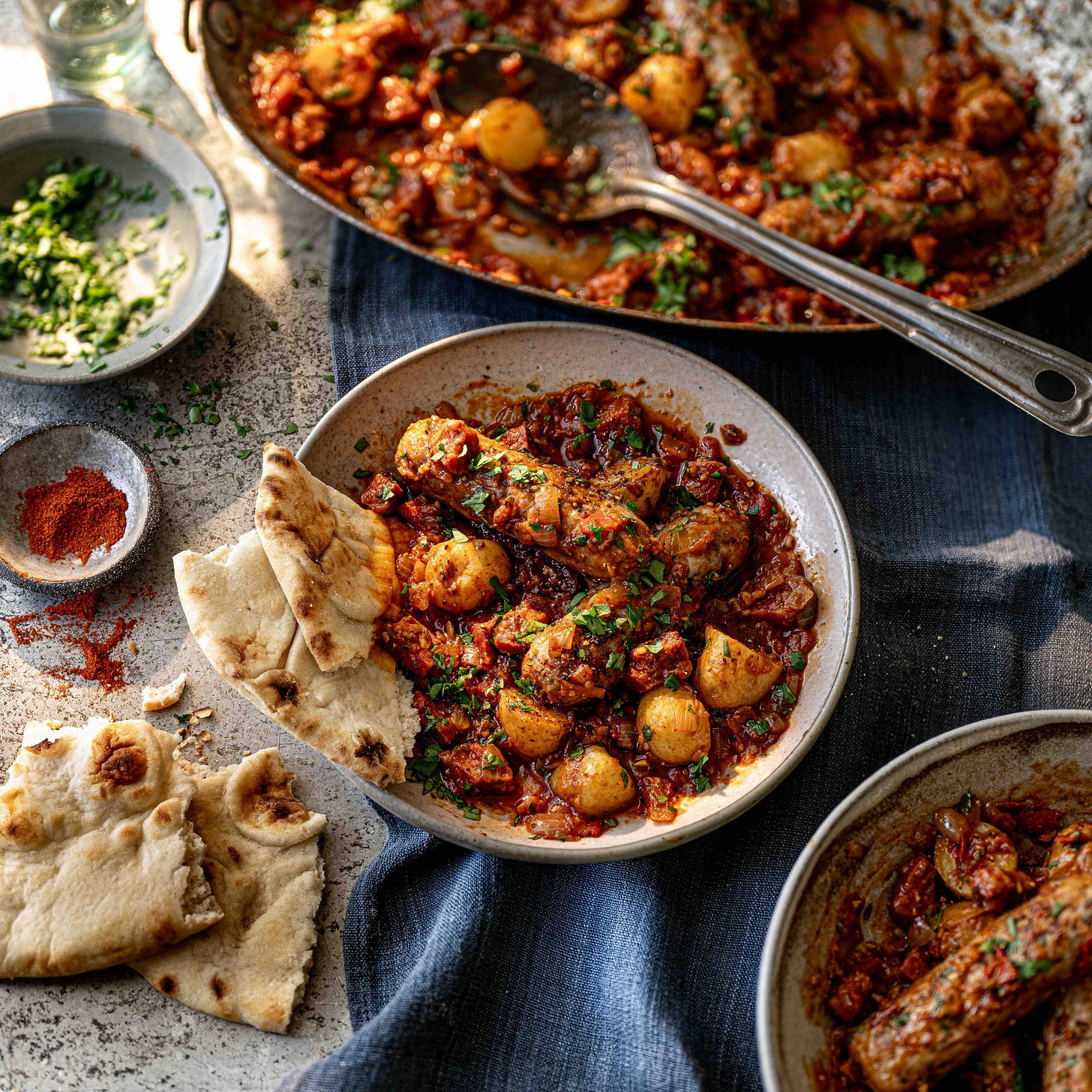It’s feeling distinctly autumnal. Along with back to school euphoria, I’ve been wondering how we are in September already and plotting a final quarter push for good food in the kitchen. The month celebrates organic produce and products, in a campaign set up by Soil Association and UK Organic, and covers textiles, beauty and well being too. It’s also a subject I feel quite conflicted about. We should all have access to food items that are good. But we don’t. So, how to tackle a month of celebrating and navigate the rest?
Pic: Keema Aloo Pie, one of three new recipes I filed for Organic September in Waitrose Weekend paper. Links below.
Firstly, a look at organic food. It has fewer pesticides, no artificial fertilisers, higher animal welfare standards, no routine use of antibiotics, no genetic modification (GM) and no artificial colours and preservatives, according to the Soil Association. It doesn’t necessarily make us healthier, especially for us inner city types who are ingesting pollution and chemicals daily. But it does have some health benefits, which include higher nutrient values and less antibiotic resistence. All in all it’s better for us, the planet, animals, nature and animals.
So we should all be filling our shopping trolleys with lots of organic fruit, veg and the rest. Except there is one very big problem with it. It is SPENNY!
Organic food is more costly to produce, and for good reason as it’s of higher quality and more labour intensive. The Soil Association, which certifies some 70% has been campaigning for government support so good food is more accessible for all. I have heard on the industry grapevine that retailers can “premiumise” organic produce by charging more for them, to profit from those who can afford to pay for them. I have also heard that declaring your grocery shop is organic-only is a sort of middle class snobbery that features at dinner party conversations. But I have no such friends to report.
First up, sobering thoughts for September
Before we consider higher welfare/quality food, we need to think about food in the first place. The Food Foundation’s Broken Plate research last year showed that healthy foods are over twice as expensive per calorie as less healthy foods, and fruit and vegetables were the most expensive part of the Government’s recommended Eat Well Plate. In January this year, their ongoing research said millions of people were skipping meals as they couldn’t afford to buy groceries.
Inflation is affecting many of us in the cost-of-living crisis, and the poor disproportionately. Recent research by the Institute for Fiscal Studies tabled “cheapflation”, where the cost of the cheapest groceries rose more sharply than premium brands. Unsuprisingly, this hit the poorest households the worse. They paid 29.1% more for their food, while much wealthier households witnessed a 23.5% increase between 2021 and 2023.
It’s worth noting that fruit and vegetable consumption is generally quite poor in the UK. Only 33% of adults and 12% of children currently eat the government recommend 5-a-day. There are a few hurdles to jump before we get to healthier diets, with lots of fruit, vegetables and other good things…
Making the transition to organic
For those of us who’d like to increase the amount of organic products in our shopping baskets but are not minted, there are some sensible ways to do this. Soil Association has some tips on how to do organic on a budget, and I’m on the lookout for a flexible veg box scheme in my local area.
There is a trademarked concept called the “Dirty Dozen” by the Environmental Working Group, which lists the 12 fruits and vegetables that were most contaminated with pesticides. A total of 46 products were tested, and the bottom represent the cleanest, so to speak. That’s at least 45 additional items for me to think about as I go about my food shopping, while simultaneously holding on for dear life to my brain cells.
I have a very simply system to share with you if you want a bit more organic in your life without breaking the bank balance. We can then hope/pray for legislation or a lottery win to go all in. I go organic (when budget allows) for the following:
Fruits and vegetables with edible skins, especially when they’re in season
Milk always to avoid antibiotic resistance (I’m a whole milk, full fat gal)
Meat only on promotion or when cheaper cuts are being used (an Indian housewive’s trick is to bulk high quality meat and fish with cheaper products)
Cheaper, more climate friendly sources of protein like eggs and beans
Bags of whoopsie produce / products at supermarkets. Save food waste, your wallet and your peace of mind - that’s a buy one get three deal if I saw one!
If you have any tips to share, I’d love to hear them!
Three new organic recipes
Waitrose commissioned me to write three simple recipes for the Organic September issue of Waitrose Weekend, and I got a chance to put my philosophy to work. I did a calculation on the cost per portion of my recipes. It was £43.91 for 12 portions of food, which worked out to £3.69 per portion. I was pleasantly suprised how cost-effective it was.
(By way of a side note, I met the amazing Dee Woods of the Landworkers’ Alliance recently who co-founded Granville Community Kitchen, an affordable, community-led veg box scheme. She told me she mostly buys local, but Waitrose is her supermarket of choice as they treat their farmers and suppliers well).
The latest issue is here, if you want to grab the following recipes which are in a feature called “Aromatic Dishes” on page 22. And here are the recipes I shared:
Keema Aloo Pie
Chicken, chickpea and pepper traybake with miso butter Savoy Cabbage
Goan-Inspired chorizo, sausage and potato one pot
It is also Sourdough September, that might have to be a post next. Happy back to life, reality and school post summer everyone.








Full of common sense as usual, Mallika. I pretty much do what you do. And often buy based on special offers etc. I get quite a lot of organic vegetables from Lidl as they are cheaper than Waitrose. The other thing I do is ask a lot of questions, particularly to the stall holders at the farmers market. The organic stall is getting prohibitively expensive for me - I use it for products I can't buy elsewhere. But there are other stalls which aren't certified organic but tell me that they do stick to organic principles. So, for example I know a particular fruit/veg farm uses no herbicides or oil based fertilisers, just pheromone traps on the cherry trees. That the chickens from the chicken and egg stall are reared in a silvopastoral system (the ideal, I think) and aren't fed soy. I'm sure the Soil Association would prefer they certified, but they talk a lot about red tape/cost and just don't think it is worth it. It is going back to trust, I think.
Very nice article on going with ORGANIC! Yes I too look out good deals on ORGANIC veggies or other stuff. Like your recipes on pies. Going to pick your book very soon "MASALA". All the best.